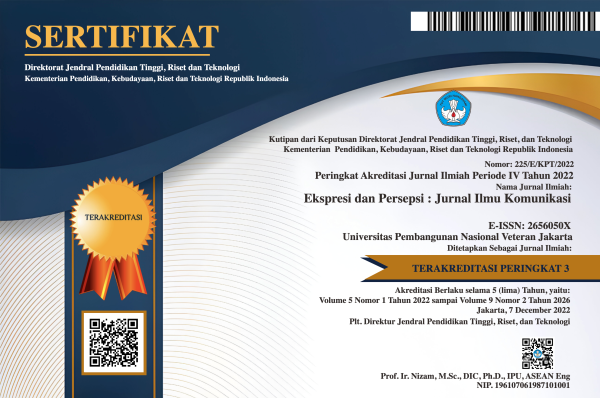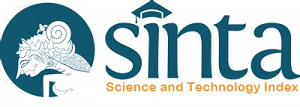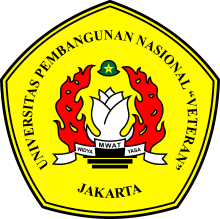SOCIAL NETWORK ANALYSIS #USUTTUNTAS PADA MEDIA SOSIAL TWITTER (DATA TWITTER 11 NOVEMBER 2022)
DOI:
https://doi.org/10.33822/jep.v6i1.5427Keywords:
Gerakan Opini Digital, #UsutTuntas, SNA, Analisa SentimenAbstract
Tragedi Kanjuruhan pada 1 Oktober tahun 2022 merupakan tragedi sepak bola dengan korban jiwa terbanyak kedua sepanjang sejarah dunia. Union of European Football Associations (UEFA) juga turut berbela sungkawa dengan melakukan hening cipta (moment of silence) pada pertandingan liga mereka. Tragedi Kanjuruhan ini memunculkan gerakan sosial dan aktivisme digital (DMO) melalui tagar #UsutTuntas. Data set yang di crawling menggunakan Netlytic.org mendapati 9.098 tweet DMO menggunakan tagar #UsutTuntas dari total 10.000 tweet. Penelitian ini akan mengukur jaringan komunikasi yang terbentuk (SNA), aktor yang terlibat, analisa wacana dan analisa sentimen. Hasil penelitian ini membuktikan bahwa gerakan opini digital Tragedi Kanjuruhan melalui tagar #UsutTuntas memiliki angka sentimen negatif tinggi yang menunjukan kekecewaan dan rasa tidak percaya oleh warganet dalam penanganan Tragedi Kanjuruhan. Rendahnya angka centralization antar aktor menunjukan bahwa DMO Tragedi Kanjuruhan melalui tagar #UsutTuntas merupakan aktivisme digital yang terjadi secara organik dan tidak dikendalikan oleh aktor maupun organisasi tertentu.References
Barisione, M., & Ceron, A. (2017). A digital movement of opinion? Contesting austerity through social media. In Social media and European politics (pp. 77–104). Springer.
Barisione, M., & Michailidou, A. (2017). Social media and European politics: Rethinking power and legitimacy in the digital era. Springer.
Burt, R. S., Kilduff, M., & Tasselli, S. (2013). Social network analysis: Foundations and frontiers on advantage. Annual Review of Psychology, 64, 527–547.
Can, U., & Alatas, B. (2019). A new direction in social network analysis: Online social network analysis problems and applications. Physica A: Statistical Mechanics and Its Applications, 535, 122372.
De Lombaerde, P., Iapadre, L., McCranie, A., & Tajoli, L. (2018). Using network analysis to study globalization, regionalization, and multi-polarity—Introduction to special section. Network Science, 6(4), 494–516.
Eriyanto. (2014). Analisis jaringan komunikasi: Strategi baru dalam penelitian ilmu komunikasi dan ilmu sosial lainnya [Communication network analysis: New strategies in research communication science other social sciences]. Prenadamedia Group Jakarta.
Fedushko, S., & Benova, E. (2019). Semantic analysis for information and communication threats detection of online service users. Procedia Computer Science, 160, 254–259.
Gruzd, A., Paulin, D., & Haythornthwaite, C. (2016). Analyzing social media and learning through content and social network analysis: A faceted methodological approach. Journal of Learning Analytics, 3(3), 46–71.
Kasture, N. R., & Bhilare, P. B. (2015). An Approach for Sentiment analysis on social networking sites. 2015 International Conference on Computing Communication Control and Automation, 390–395.
Kaun, A., Kyriakidou, M., & Uldam, J. (2016). Political agency at the digital crossroads? Media and Communication, 4 (4), 1–7.
Morissan, M. A. (2018). Manajemen Media Penyiaran: Strategi Mengelola Radio & Televisi Ed. Revisi. Prenada Media.
Mostafa, M. M. (2013). More than words: Social networks’ text mining for consumer brand sentiments. Expert Systems with Applications, 40(10), 4241–4251.
Mulyadi, U., & Fitriana, L. (2018). Hashtag (#) as message identity in virtual community. Jurnal The Messenger, 10(1), 44–53.
Muqsith, M. A. (2019). The Relationship Of Political Socialization Messages Relations In Social Media Twitter With The Image Of PKS.(Study: Political Socialization PKS Through@ PKSejahtera Account). EKSPRESI DAN PERSEPSI: JURNAL ILMU KOMUNIKASI, 2(1), 3–12.
Otrel-Cass, K. (2019). Epilogue: Of Scales, Spaces, Meshworks, and Maps of Connections. In K. Otrel-Cass (Ed.), Hyperconnectivity and Digital Reality: Towards the Eutopia of Being Human (pp. 145–153). Springer International Publishing. https://doi.org/10.1007/978-3-030-24143-8_9
Permatasari, N., & Trijayanto, D. (2017). Motif Eksistensi melalui penggunaan hashtag (# OOTD) di media sosial instagram. Promedia, 3(2), 252–273.
Puspita, R., & Suciati, T. N. (2020). Mobile Phone dan Media Sosial: Penggunaan dan Tantangannya pada Jurnalisme Online Indonesia. Ekspresi Dan Persepsi: Jurnal Ilmu Komunikasi, 3(2), 132–146.
Steinley, D. L., & Brusco, M. J. (2019). Using an Iterative Reallocation Partitioning Algorithm to Verify Test Multidimensionality. Journal of Classification, 36(3), 397–413. https://doi.org/10.1007/s00357-019-09347-z
Styawati, S., & Mustofa, K. (2019). A Support Vector Machine-Firefly Algorithm for Movie Opinion Data Classification. IJCCS (Indonesian Journal of Computing and Cybernetics Systems), 13(3), Article 3. https://doi.org/10.22146/ijccs.41302
Sultanatta, C., & Maryam, S. (2019). Analisis Semiotika Logo Brodo Footweardi Media Sosial Twitter (Studi Analisis Semiotika Roland Barthes). Ekspresi Dan Persepsi : Jurnal Ilmu Komunikasi, 1(01). https://doi.org/10.33822/jep.v1i01.448
Van Dijk, T. A. (2015). Critical Discourse Analysis. In The Handbook of Discourse Analysis (pp. 466–485). John Wiley & Sons, Ltd. https://doi.org/10.1002/9781118584194.ch22
Van Laer, J., & Van Aelst, P. (2010). Internet and Social Movement Action Repertoires. Information, Communication & Society, 13(8), 1146–1171. https://doi.org/10.1080/13691181003628307
Vega-Muñoz, A., & Arjona-Fuentes, J. M. (2020). Social Networks and Graph Theory in the Search for Distant Knowledge: Studying the Field of Industrial Engineering [Chapter]. Handbook of Research on Advanced Applications of Graph Theory in Modern Society; IGI Global. https://doi.org/10.4018/978-1-5225-9380-5.ch017
Watts, W. D. (2003). Networks, Dynamics and The Small World Phenomenon. American Journal of Sociology, 105(2), 50–59.
White, H. C., Boorman, S. A., & Breiger, R. L. (1976). Social Structure from Multiple Networks. I. Blockmodels of Roles and Positions. American Journal of Sociology, 81(4), 730–780. https://doi.org/10.1086/226141
White, H. D., Wellman, B., & Nazer, N. (2004). Does citation reflect social structure?: Longitudinal evidence from the ?Globenet? Interdisciplinary research group. Journal of the American Society for Information Science and Technology, 55(2), 111–126. https://doi.org/10.1002/asi.10369
Downloads
Published
Issue
Section
License
Copyright (c) 2023 M Fadhlillah Setiamukti, MF Nasvian

This work is licensed under a Creative Commons Attribution-NonCommercial 4.0 International License.














